Is it possible to make money from old photos? Tracy Calder explores how you can make money from old photographs hiding in your collections, plus shares tips on how to handle and store photographic material
In 2014 Australian landscape photographer Peter Lik sold a black & white print of his image ‘Phantom’ (shot in Antelope Canyon, Arizona) for $6.5 million. The sale was both private and anonymous, so the official figure is debatable, but the fact that photographs now make big bucks certainly isn’t.
Perhaps a more reliable example is Andreas Gursky’s image ‘The Rhine II’, which fetched $4.3 million at auction in 2011. These images were obviously produced for the fine art market, but things get a little more interesting when you consider some of the less obvious prints to go under the hammer in recent years.
An extremely rare album of vintage photographs entitled Views on the North River, by Victorian travel photographer John Thomson, recently sold for £48,000 at Dominic Winter Auctioneers in Gloucestershire. ‘My heart nearly stopped when I saw the title-page for I instantly recognised it as a rarity, but it was only later when researching it that I discovered there are only a handful of copies known,’ said auctioneer and photography specialist Chris Albury in the Express & Star.
The family who owned this big-ticket item only discovered its true worth after taking a box of antiquarian books and albums to the auction house to be valued. Stories like this prompt people to head into their lofts to see if the box of old prints the previous owner left behind are worth flogging on. But can you really make money from old photos? How do you know what you’ve got, and where can you sell them?

Family snaps, while evocative, may not have much value beyond sentimental. Credit: Tracy Calder
Where to look for old photos
Prior to the 1960s, when major galleries began to accept photography as art and auction houses and dealers gained confidence in the re-sale value of work that could, essentially, be mass-produced, you could pick up classic prints for a song. In the 1970s private collectors Sondra Gilman and her husband Celso Gonzalez-Falla purchased three Eugène Atget prints for $750, for example.
(Amusingly, her friends still thought she was mad for paying that much!) You’d be hard pushed to find such a bargain today, but that’s not to say it’s impossible. You’re unlikely to stumble across a print of Ansel Adams’ ‘Moonrise, Hernandez, New Mexico’, in the loft, so for most of us buying and selling old photos involves a bit of treasure hunting.
Photographic prints and albums can be purchased from car boot sales, house clearance shops, photo fairs, auctions, dealers, galleries and even the artists themselves. But when deciding what to buy it’s important to engage both your head and your heart. Curator and critic Gerry Badger, whose book Collecting Photography (published by Mitchell Beazley in 2003) is a must-read for any print buyer, suggests making your first few purchases on one basis, ‘You know you like these images, and want to have them on your walls.’
Collector and curator W M Hunt takes this a step further by suggesting you wait for an emotional reaction before parting with your money. ‘Look at the hair on the back of your hand,’ he advised at a New York photo festival in 2008. ‘Listen to your heart. Commit.’ While it might seem strange to o er the advice ‘buy what you love’ when it comes to purchasing prints with the sole aim of selling them on, bear two things in mind: first, you might not be able to sell the work, so it’s better to have something you like hanging on your wall, and second, if you fall in love with a picture it’s more than likely someone else will too.
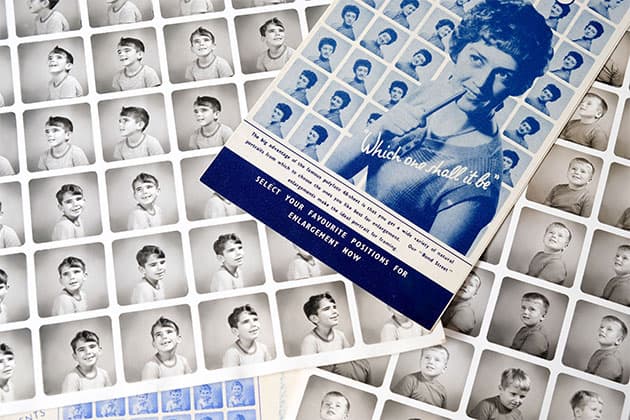
Contact sheets from a skilled shooter can be of interest, and can make fun artworks. Credit: Tracy Calder
What to look for
Some areas of photography are still significantly undervalued, so if you’re willing to hang on to a piece for a while you might find that your patience pays off. As a starting point, there’s plenty to be gained from investing in slightly unusual pieces, as print dealers K&J Jacobson reveal on their website.
‘Hand-coloured photographs, cartes de visite, photographic artist’s studies, the so-called “vernacular” press prints and early views of neglected corners of the world, are still areas which are underrated,’ they suggest. ‘The rulebook as to which photography is worth collecting is still being written’. The golden rule is to buy quality. If you’ve ever watched Antiques Roadshow you’ll have heard the line, ‘If this were in its original condition it would be worth £20k, but with the damage it will make about £2k at auction.’ It’s a crushing blow.
The art world loves vintage. Nowadays this word is used to describe everything from cheese to cars, but in photographic circles it generally refers to a print that was made within five years of the original negative. You might see dealers and auction houses listing prints as ‘later printed’, ‘late prints’ or ‘modern prints’, which generally means that the photographer made the print from the original negative outside of this period.
Limited-edition prints are a great way for a photographer to make money, but before you splash out make sure that you are absolutely clear what ‘limited’ means – does it refer to the size of the artwork, the process used to create it, the number of prints made from the original negative etc. Accept that you are going to make some mistakes, but try not to make them expensive ones.
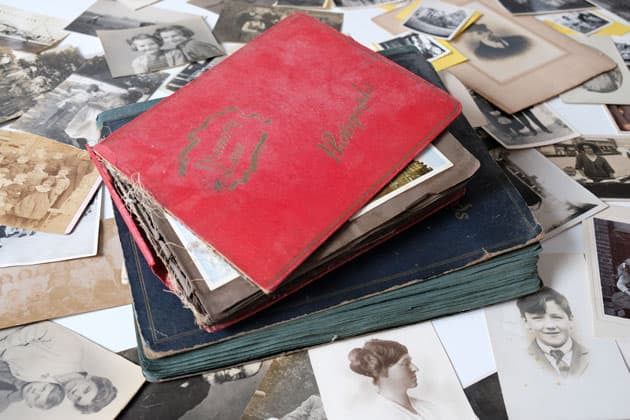
Identify what you have in your collection; this will help when it comes to storage. Credit: Tracy Calder
How to sell your old photos and make money – Auction tips from experts
If you’ve uncovered a potential gem, take it to an auction house and get it valued (some houses, such as Sotheby’s, offer online estimates). ‘It’s amazing what turns up,’ reveals Richard Fattorini, senior director, senior specialist at Sotheby’s. ‘Prints and albums brought in by people who had ancestors in the far East in the 19th and early 20th century and didn’t realise the value.’
Valuations are usually free, but you pay commission based on the selling price, which can be quite a hefty sum. Ideally you want your prints/albums/slides to be part of a specialist photography sale, thus attracting the maximum number of interested parties.
When assessing the value of your art, any specialist worth their salt will be looking at provenance, condition, artist and current demand. Some of the larger auction houses only accept items above a certain value (say £3,000), but local houses tend to be less restrictive. If you’re looking for items to buy and sell on, you are better off frequenting the smaller houses.
If you’re buying a print at auction scan the listing for terms such as ‘from the workshop of Ansel Adams’, which might indicate a print made by a student of Adams, rather than the man himself. When you make a bid you’re entering into a binding contract with the auction house, so be sure to look out for terms such as ‘attributed to’, ‘in the style of’ and ‘follower of’ – all of which will have a bearing on the value. Before holding up your paddle, make sure you’ve done your homework.
If you’ve found an item you like online or in the sale catalogue there’s no substitute for going along and, where possible, viewing and handling it yourself. If you can’t visit the showroom in person, larger houses can usually issue you with a condition report that provides detailed information about the physical condition of a piece.
Just remember that while this document might have been prepared by an expert, his or her definition of ‘acceptable’ might well differ from yours. Also, bear in mind that delicate photographic items can be damaged by excessive handling on viewing days, so make sure that you have another look on the day of the sale. After all, you’re buying ‘as is’ or ‘as seen’.
If you want to bag a bargain, pay attention to any lots that fail to meet the reserve agreed between the seller and the auctioneer. These lots are described as ‘bought in’, and ownership remains with the vendor. The auctioneer will draw attention to such pieces by saying ‘pass’ or ‘unsold’, and move along quickly. If this happens to a print you’re interested in it’s worth approaching a member of staff at the end of the sale and offering to pay the reserve price. If the owner agrees, it’s yours.
How to store your photo collection
While you’re building up a collection, it’s important to store your prints, negatives and slides properly. Each item will have specific needs: an albumen print, for example, will require different treatment to a C-type print, due to the materials and processes involved in its creation. Before you put a preservation plan into action you need to identify what you have, how it was made, and what it was made from.
There are plenty of online resources to assist you in this task, but a good basic guide can be found on the V&A’s website. A daguerreotype, for example, might consist of silver-plated sheets of copper, behind glass, presented in a leather or paper case.
Each of these materials will degrade in a different way. By working out exactly which materials and processes have been used, you can deal with each piece sympathetically, helping to ensure its preservation.
Whether you’re selling photographic materials for fun, or purely financial gain, you might find yourself the temporary custodian of an object of significant historical value. Be sure to treat it with the reverence it deserves.
How to handle vintage photographic materials

Credit: Tracy Calder
Clean and cover surfaces
Make sure any surface you lay your prints on has been thoroughly cleaned (without abrasive chemicals), and covered with unbleached paper. If you’re looking at glass plates, magic lantern slides etc, lay a thin piece of archival foam down first.
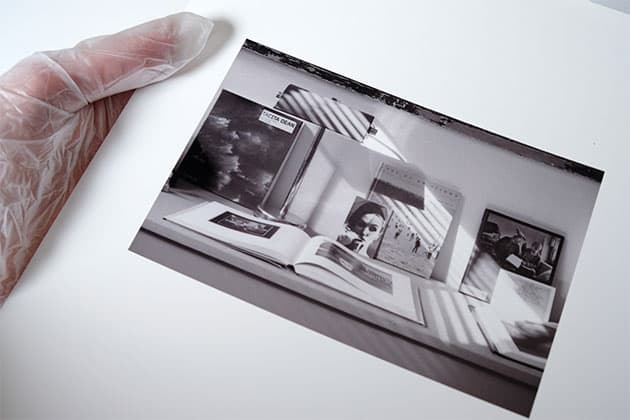
Credit: Tracy Calder
Wear gloves
Oil and perspiration from skin can leave traces on prints, so wear gloves when handling photographic material. Nitrile versions are best, as cotton gloves can shed fibres and it’s easier to catch corners or tear a print while wearing them due to reduced dexterity.
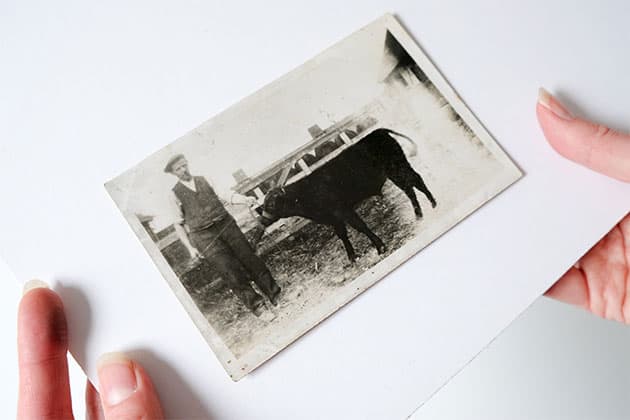
Credit: Tracy Calder
Use a board
If you need to move a print from one place to another lay it emulsion-side up on a thick board rather than carrying it in your hands. It’s very easy to crease a print or walk into something if you’re not paying attention!
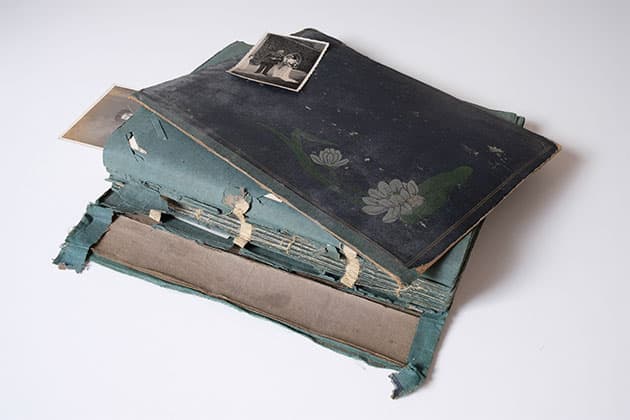
Credit: Tracy Calder
Slow down
Glass plates can get stuck inside envelopes, negatives can become stiff and brittle, antique photo albums can develop fragile spines or loose leaves. Take your time when assessing new acquisitions.

Credit: Tracy Calder
Understand the process
The best way to store and handle your vintage photographs will often depend on the processes used create them. The Victoria & Albert Museum provides a good guide to the photographic process on its website, www.vam.ac.uk.
Useful resources
- Artnet www.artnet.com
- Artprice www.artprice.com
- Christie’s www.christies.com
- Gordon’s and Blouin Art Sales Index www.gordonsart.com
- Phillips www.phillips.com
- Preservation Equipment Ltd www.preservationequipment.com
- Silverprint www.silverprint.co.uk
- Sotheby’s www.sothebys.com
- Victoria & Albert Museum www.vam.ac.uk
Further reading







